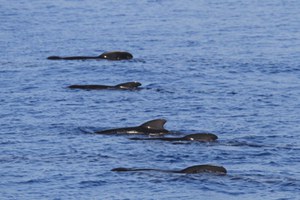Cetaceans, Maritime Traffic, and Management Tools in the Strait of Gibraltar. Proposals for a Challenging yet Not Impossible Coexistence
The transboundary area of the Strait of Gibraltar is home to seven protected cetacean species and stands as one of the world's marine areas most threatened by high-intensity maritime traffic.
Following the protocol of the Mediterranean network: Fixed Line Transect Mediterranean Monitoring Network (FLT Med Net) led by ISPRA, the Nereide association has analyzed data on cetaceans and maritime traffic collected aboard Balearia company ferries (on the Algeciras-Ceuta and Algeciras-Tanger Med routes in 2018 and 2019. A total of 264 sightings were recorded, including all species present in the Strait. 4 near-collision events were reported involving pilot whales, common rorquals, and sperm whales. Through this work, it was possible to identify high-risk areas by overlaying the areas of highest cetacean abundance with those of increased traffic. Additionally, the study revealed how fishing activities can exert greater pressure on common dolphins, bottlenose dolphins, and common dolphins, while merchant marine vessels may pose threats to larger species such as sperm whales and rorquals.
The group of researchers proposes the designation of:
- A protected area in the Strait with international and seasonal characteristics, including permanent speed reduction in certain zones (maximum speed of 13 knots).
- The establishment of a microsanctuary, also seasonal and depending on the time of year with a higher presence of dolphins, in the bay between Algeciras and Gibraltar.
The Strait of Gibraltar is a crucial area for marine mammals, requiring an integrated transboundary maritime space management policy based on scientific evidence. Thanks to the monitoring efforts of the Nereide association within the FLT Med Net, using ferries as research platforms, concrete proposals have been formulated to reduce anthropogenic pressure from traffic and protect the cetaceans of the Strait, fostering a more harmonious coexistence.
The study has recently been published in the international scientific journal Aquatic Conservation: Marine and Freshwater Ecosystems and is available online: https://onlinelibrary.wiley.com/doi/10.1002/aqc.4066.
For further information, please contact Alessia Scuderi (alessia.scuderi1@gmail.com, +34 692 60 65 64) and Antonella Arcangeli (antonella.arcangeli@isprambiente.it, +39 349 327 2200).
Scuderi A., Campana I., Gregorietti M., Moreno E.M., Sanabria J.G., Arcangeli A. (2024). Tying up loose ends together: Cetaceans, maritime traffic and spatial management tools in the Strait of Gibraltar. https://doi.org/10.1002/aqc.4066

